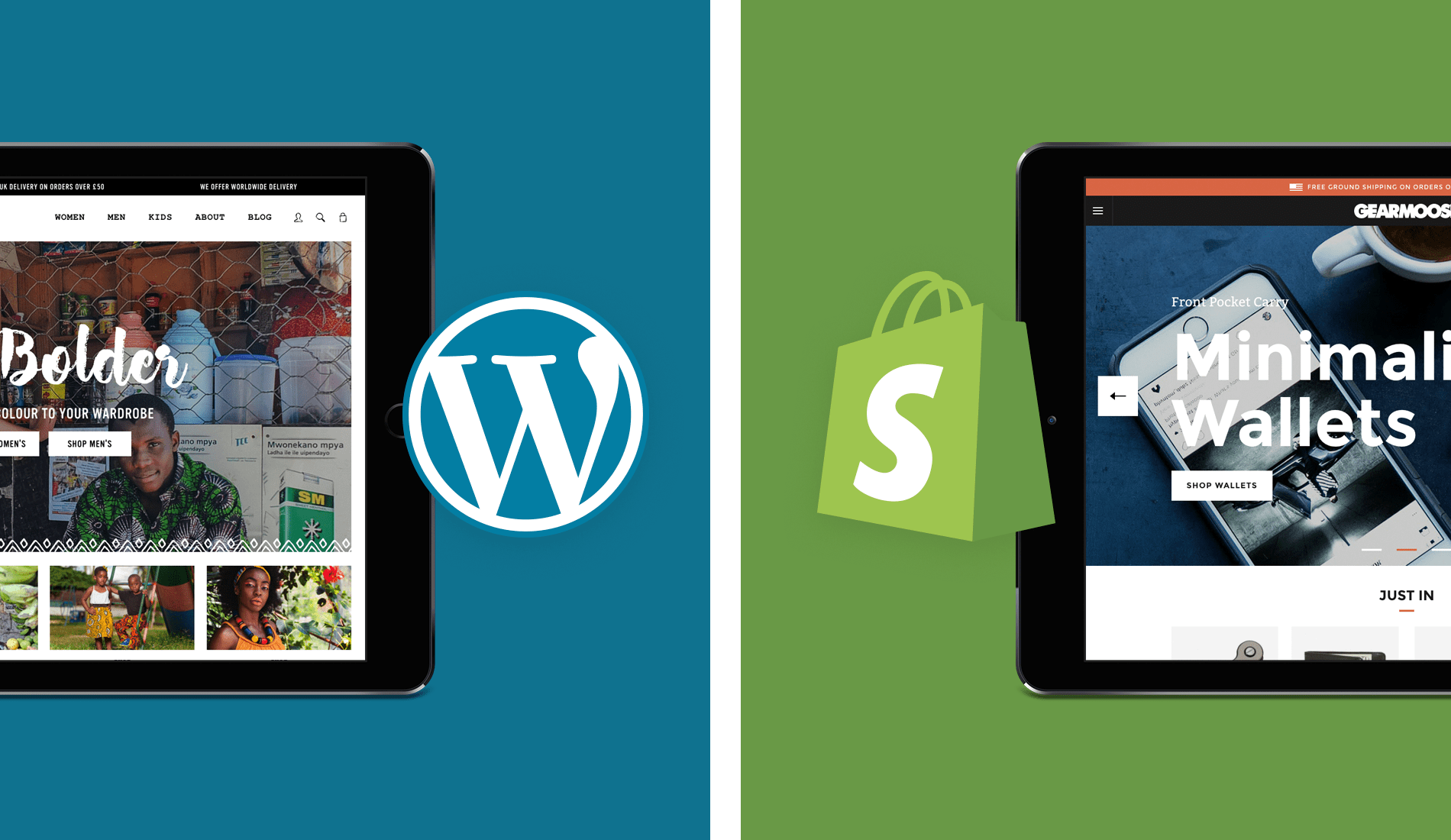As a store owner, the eCommerce platform you choose will become the backbone of your online business. With numerous options available, selecting the right platform can be daunting.
While Shopify has established itself as a leader in the eCommerce space, it is not a one-size-fits-all solution for every business. It’s also worth saying we’re massive fans of Shopify. We’ve built some exciting stores for brands like Magic Rock and Fourpure Beer. We’ve even created some complex stores on Shopify with custom apps for made-to-measure curtains, and AI-generated fabrics for The Millshop Online.
Although we build in Shopify, our web design agency also specialises in WooCommerce and BigCommerce, so this guide explores several Shopify alternatives like WooCommerce, Adobe Commerce, BigCommerce, and more with an aim to help you find the perfect fit for your business needs.
This Article Will Cover:
Introduction
The landscape of eCommerce platforms is diverse, offering various solutions tailored to different business sizes, needs, and technical expertise.
Shopify, known for its ease of use and comprehensive features, has become a popular choice. However, businesses may seek alternatives for reasons like cost, specific feature requirements, or platform flexibility.
This article reviews several leading eCommerce platforms exploring why an alternative might be the better option for your business.
You Might Want To Read: What Is Shopify and How Does It Work?

What are your eCommerce Needs?
Before exploring the alternatives, it’s crucial to identify your business needs. Whether you’re a small startup or a growing enterprise, the right platform can significantly impact your online presence and sales. Consider customisation, payment options, scalability, and technical support. A checklist of common features to evaluate can help you make an informed decision that aligns with your business goals.
E-commerce Platform Evaluation Checklist
Here’s a checklist of common features to evaluate:
- Customisation Options:
- Ability to customise the look and feel of your store
- Availability of themes and templates, both free and paid
- Flexibility in modifying HTML/CSS for deeper customisation
- Options for customising checkout processes
- Payment Options:
- Support for multiple payment gateways (e.g., PayPal, Stripe, credit cards)
- Integration with local payment methods
- Support for international currencies and tax calculations
- Options for recurring payments or subscriptions
- Scalability:
- Ability to handle increasing volumes of traffic and transactions
- Flexibility to add new products and categories as your business grows
- Support for multi-channel selling (online, in-person, social media, marketplaces)
- Ease of platform migration if needed
- Technical Support:
- Availability of 24/7 customer support (live chat, phone, email)
- Access to a comprehensive knowledge base or help centre
- Community forums or user groups for additional support
- Availability of professional services for setup, customisation, and troubleshooting
- Additional Considerations:
- Integration with marketing tools (email marketing, social media, SEO)
- Availability of analytics and reporting tools
- Inventory management capabilities
- Shipping and fulfilment options, including integration with major carriers
- Security features (SSL certificates, PCI compliance)
- Mobile responsiveness and optimization
- Cost, including setup fees, monthly fees, and transaction fees
Although not exhaustive, this checklist can serve as a great foundation for evaluating potential e-commerce platforms. It will ensure that you select a solution that not only meets your current needs but also supports your business as it grows and evolves.
1. WooCommerce: The Open-Source Contender
WooCommerce stands out as a highly flexible eCommerce platform, renowned for its extensive library of plugins and themes that enable users to tailor their online stores to their exact specifications. This open-source solution, designed to integrate seamlessly with WordPress, allows for a high degree of customisation, enabling businesses to create a unique online presence that can evolve alongside their growth. The platform’s adaptability makes it a favourite among merchants who wish to exercise creative control over their eCommerce sites, from the user interface design to the functionality of shopping carts and checkout processes.

However, the freedom and versatility offered by WooCommerce come with the requirement for a more proactive approach to website management. Unlike fully hosted eCommerce solutions, where the service provider manages technical aspects such as hosting, security, and data backups, WooCommerce places these responsibilities squarely on the user. To run a WooCommerce-powered store effectively, you’ll need some technical knowledge and expertise or find a WooCommerce agency like ours to help.
The necessity for hands-on management encompasses several key areas. Firstly, selecting a reliable hosting service becomes crucial, as this will directly impact your website’s loading speed, uptime, and overall performance. Users must also stay vigilant about security, implementing measures to protect against online threats and ensure the safe processing of customer transactions. Regularly updating the WordPress core, WooCommerce plugin, and any additional themes or plugins is essential to maintaining a secure environment. Furthermore, managing backups is another critical task, requiring users to periodically save copies of their website data to prevent loss in case of technical failures or cyber-attacks.
For individuals and businesses lacking in technical skills or those who prefer not to delve into the intricacies of website management, these requirements can pose significant challenges. The need to oversee hosting, security, and backups not only demands time and effort but also a level of comfort with technical tasks that not everyone possesses. This aspect of WooCommerce, while a testament to its flexibility and power, highlights a potential drawback for users seeking a more hands-off approach to running their online store.
In summary, while WooCommerce offers an unparalleled opportunity for customisation and growth, you may want to contact us so we can address any concerns and help manage a store for you. For users willing to embrace these challenges, WooCommerce can be an incredibly rewarding platform. However, for those looking for simpler, more straightforward solutions, exploring alternatives like Shopify that offer fully managed services may be a more appropriate path.
You Might Want To Read: WooCommerce vs Shopify: Which Is Better & Why?
2. BigCommerce: The Versatile All-Rounder
BigCommerce emerges as a formidable player in the eCommerce platform arena, distinguished by its comprehensive suite of features, not to dissimalr to Shopify.
BigCommerce is adept at serving a wide array of business sizes and types, making it an ideal choice for small startups venturing into the online marketplace for the first time and large enterprises looking to scale their operations and enhance their online sales channels. One of BigCommerce’s hallmark features is its extensive range of built-in functionalities, which cover everything from advanced product options and inventory management to SEO tools and analytics. These features equip businesses with the tools they need to build, manage, and grow their online stores effectively.

Scalability is another key advantage of BigCommerce. It allows businesses to expand their operations without the need to migrate to more robust platforms as their sales volume and customer base grow. This makes BigCommerce a future-proof choice for businesses that anticipate rapid growth. Additionally, the platform’s multi-channel selling capabilities enable merchants to sell through their websites and across various online marketplaces and social media platforms, increasing their reach and potential for sales.
Renowned for its user-friendly interface, BigCommerce simplifies setting up and managing an online store. This ease of use extends to its theme customisation options and intuitive dashboard, which provides clear insights into sales trends, inventory levels, and customer interactions. Beyond the platform itself, BigCommerce is celebrated for its exceptional customer support. Merchants have access to a wealth of resources, including 24/7 live chat support, extensive online documentation, community forums, and a network of professional services and partners.
The platform’s diverse app marketplace further enhances its appeal, offering a plethora of third-party applications and integrations that extend the functionality of online stores. Whether businesses need specialised marketing tools, shipping and fulfilment solutions, or customer relationship management systems, the BigCommerce marketplace likely has an app to meet those needs.
However, for all its strengths, BigCommerce introduces a unique pricing structure that may require consideration, especially by businesses experiencing rapid growth. The platform employs pricing tiers based on annual sales volume, meaning that as a business’s sales increase, it may be moved to a higher pricing tier. While this model supports scaling by aligning the platform’s costs with the merchant’s success, it can also lead to increased expenses as sales volumes grow. This aspect of BigCommerce’s pricing warrants careful planning and budgeting by businesses to ensure that the platform remains a cost-effective solution throughout their growth trajectory.
In essence, BigCommerce stands as a highly capable and flexible solution for eCommerce businesses at any stage of growth. Its all-encompassing feature set, combined with ease of use, scalability, and strong support infrastructure, positions it as a top contender for businesses seeking a robust online sales platform. Nonetheless, the consideration of its sales volume-based pricing is crucial for businesses planning for long-term growth and scalability.
You Might Want To Read: 8 Must-Have Features for eCommerce Websites
3. Adobe Commerce: The Enterprise Solution
Adobe Commerce, previously recognised as Magento, positions itself as a premier e-commerce platform catering specifically to the needs of larger businesses and enterprises. Alongside a robust set of features that facilitate a comprehensive and sophisticated online retail experience, Adobe Commerce is known for its extensive feature set, designed to accommodate the complex needs of large-scale eCommerce operations.
However, this richness in features can lead to what some may perceive as “bloat,” where the platform becomes so feature-dense that it affects performance and usability for teams trying to run a store. For businesses that require a simpler e-commerce solution, the extensive functionalities of Adobe Commerce can be overwhelming and unnecessary.
Opting not to use Adobe Commerce can be a valid choice for various reasons, particularly for businesses that are concerned about platform bloat and cost. While Adobe Commerce offers a robust set of features and unparalleled customisation capabilities, these advantages can also translate into potential drawbacks for certain businesses. Here are some reasons why Adobe Commerce might be considered bloated and expensive, and why some businesses choose to explore alternative solutions:
High Cost of Ownership
- Initial and Ongoing Costs: Adobe Commerce, particularly its Commerce edition, comes with a licensing fee that can be quite steep for small to medium-sized businesses. In addition to these licensing fees, the costs associated with custom development, maintenance, and updates can add up, contributing to a high total cost of ownership.
- Development and Maintenance Expenses: The platform’s complexity and the need for customization typically require the expertise of experienced developers. Hiring such talent or contracting a development agency adds significant expenses, which can be a barrier for businesses with limited budgets.
Technical Expertise Required
- Need for Specialised Skills: Successfully deploying and managing an Adobe Commerce site often requires advanced technical skills, including familiarity with its architecture and programming. Businesses without access to skilled developers may find it challenging to customize and maintain their site effectively, leading to additional costs for training or hiring qualified personnel.
For businesses that find Adobe Commerce to be too bloated or expensive, numerous alternative e-commerce platforms offer a more streamlined user experience and lower cost of entry. Platforms like Shopify, BigCommerce, and WooCommerce as explored already offer user-friendly interfaces, essential e-commerce features, and scalability, without the complexity and high costs associated with Adobe Commerce. These alternatives can be particularly appealing for small to medium-sized businesses looking for cost-effective solutions that are easier to manage and can still support their growth.
You Might Want To Read: Migrate from Magento to Shopify (Adobe Commerce)
5. Squarespace: Simplicity Meets Choice
While Squarespace is lauded for its sleek design templates and user-friendly interface, making it an attractive choice for entrepreneurs and small businesses venturing into creating a brochure website, it may not be the ideal platform for eCommerce. Here are some reasons why Squarespace might not suit your e-commerce needs:
Limited E-commerce Functionalities
- Basic E-commerce Features: Squarespace provides a solid foundation for small-scale online stores with its integrated e-commerce capabilities. However, businesses looking for advanced e-commerce features such as complex discounting rules, subscription services, or extensive customer segmentation may find Squarespace’s offerings limited.
- Payment Gateway Options: Squarespace’s support for payment gateways is relatively limited, primarily to Stripe, PayPal, and Square for in-person sales. This limitation can be a significant constraint for businesses looking to offer a wider range of payment options to accommodate customer preferences across different regions.

Scalability Concerns
- Growth Limitations: While Squarespace can efficiently support small to medium-sized businesses, its platform may not scale as seamlessly for high-volume stores or rapidly growing enterprises. Businesses that anticipate significant growth might encounter limitations in Squarespace’s ability to handle increased traffic, large product inventories, and complex operational needs.
- Customisation Restrictions: Squarespace’s ease of use comes at the cost of deep customisation. The platform uses a proprietary system that limits access to the back-end code, making it challenging to implement custom functionalities or integrate with specific third-party systems and applications beyond those officially supported.
SEO and Marketing Limitations
- SEO Customisation: Squarespace provides basic SEO tools that can help optimise your site for search engines. However, businesses looking for advanced SEO features and granular control over search optimisation might find Squarespace’s capabilities insufficient for competing in highly saturated markets or niches.
- Marketing Tools: While Squarespace includes essential marketing tools, its ecosystem is not as extensive as some competitors. This might pose challenges for businesses that rely heavily on sophisticated email marketing, customer relationship management (CRM) systems, and other advanced marketing strategies.
Integration and App Ecosystem
- Limited Third-Party Integrations: Compared to platforms like Shopify or WooCommerce, Squarespace offers fewer integrations with external services and applications. This limitation can restrict businesses from leveraging specific tools or platforms they need to streamline operations, enhance customer experience, or expand their marketing efforts.
Pricing and Value
- Cost vs. Features: When evaluating the cost of Squarespace’s e-commerce plans against the features and flexibility offered, some businesses may find that the value does not align with their needs, especially if they require advanced eCommerce functionalities that necessitate additional investments in third-party services or custom development work.
While Squarespace is an excellent platform for businesses prioritising design and simplicity for their online store, it may not be the best fit for everyone. Businesses with advanced e-commerce needs, those anticipating rapid growth, or those requiring extensive customization and a broad range of integrations might need to consider alternative platforms better suited to their complex requirements.
6. Wix and Weebly
Beyond the big players, the marketplace offers two other minor alternatives to Shopify: Wix and Weebly.
Note: We wouldn’t endorse or use either of these platforms as a specialist eCommerce agency, but we realise they have their place in the market, especially for small start-ups on a shoe-string budget, so it’s worth highlighting them in this space.
These platforms distinguish themselves through their user-friendly interfaces and distinct features, catering to businesses in start-up mode.
Wix and Weebly present themselves as accessible and user-friendly platforms, offering a straightforward path for individuals and small businesses to venture into online selling. With their drag-and-drop interfaces, Wix and Weebly allow users to create an online store with relative ease, even for those with no prior web development experience. These platforms cater especially well to newcomers in the merchant marketplace, providing a suite of basic e-commerce functionalities such as product listings, payment processing, and basic inventory management.
However, while they facilitate a quick launch into the online selling space, they do come with their set of limitations, particularly when it comes to achieving a highly polished and customised design. The platform’s strengths in simplicity and ease of use can, paradoxically, act as its weakness for businesses aiming to stand out in a competitive online environment. The template-driven approach, although convenient, may restrict creative freedom, leading to websites that can feel somewhat generic or lacking in uniqueness. For brands where bespoke design and distinctive online identity are crucial, this could pose a significant limitation.
Moreover, as businesses grow and their needs evolve, Wix and Weebly eCommerce might not scale as seamlessly as some other more robust platforms. Advanced eCommerce features, such as sophisticated customer segmentation, complex discount and pricing strategies, and extensive third-party integrations, may be more challenging to implement within the Wix and Weebly environments. This could lead to growing businesses encountering barriers as they attempt to expand their online offerings or enhance their operational efficiencies.
Additionally, while Wix and Weebly do offer an array of basic eCommerce capabilities, the platform’s focus on simplicity means that some of the more advanced or specialised functionalities available on dedicated eCommerce platforms like Shopify or BigCommerce are not as developed or might require workaround solutions. For instance, high-level SEO customisation, detailed analytics, and advanced shipping options won’t be as comprehensive or intuitive to set up and manage on Wix or Weebly.
In summary, Wix and Weebly are an attractive option for those just starting out or with modest needs, thanks to its user-friendly interface and the speed with which one can set up an online store. However, businesses focused on crafting a distinct, polished online brand identity, or those with advanced eCommerce requirements, stay clear. You’ll quickly find the platform’s design constraints and functional limitations a hindrance to your growth and differentiation in the market.
7. Comparing the Platforms
Wow, that’s a lot of information to digest. So, we’ve created a comparison summarising the primary distinctions between Shopify, WooCommerce, and BigCommerce, the platforms we specialise in as a web design agency, and know through and through. Any of these three platforms is a strong contender for your store:
| Feature | Shopify | WooCommerce | BigCommerce |
|---|---|---|---|
| Platform Type | Hosted | Open-source (Self-hosted) | Hosted |
| Ease of Use | Very user-friendly | Depends on WordPress experience | User-friendly |
| Customization | High (with limitations in the free themes) | Very high (full control over code) | High (with some limitations) |
| Payment Gateways | Supports 100+ gateways | Depends on WordPress plugins | Supports 65+ gateways |
| Scalability | Highly scalable | Scalable with the right hosting | Highly scalable |
| SEO Capabilities | Strong | Dependent on themes and plugins | Strong, with built-in features |
| Integrations & Apps | Extensive app store | Extensive, through WordPress plugins | Wide range of built-in features and additional apps |
| Pricing | Subscription-based, starting at $29.95/month | Free, but costs for hosting, themes, and plugins | Subscription based, starting at $29.95/month |
| Technical Support | 24/7 Support via chat, email, and phone | Community support, limited direct support | 24/7 Support via chat, email, and phone |
| Ideal For | Businesses of all sizes | Tech-savvy merchants and WordPress users | Growing businesses and enterprises |
What Next?
Choosing the right eCommerce platform is a critical decision that can influence the success of your online business. By carefully considering your business needs and evaluating each platform’s features, pricing, and potential limitations, you can select a solution that aligns with your goals.
Or skip that process and contact one of our eCommerce experts. We can continue the conversation on finding the ideal eCommerce solution for your business needs. Our comprehensive knowledge, insights, and information will help you make an informed decision. After all, we are a Shopify Partner Agency to boot.
You Might Want To Read: What Is A Shopify Partner? Everything You Need To Know
We’ll aim to help you navigate the complex world of eCommerce platforms and discover the best Shopify alternative for your business. Shopify might even be the platform of choice! Let’s talk.



